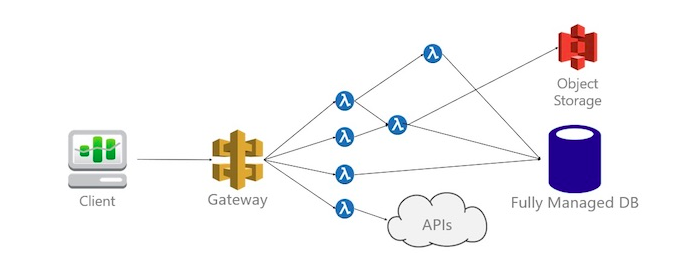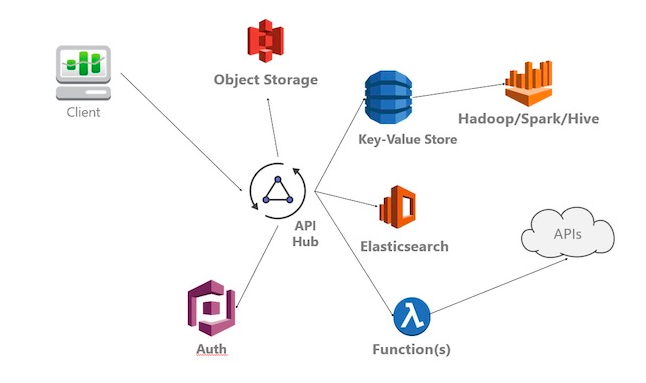The software development is adopting the formula of less coding which means consistent development velocity and successful maintenance.
With no server operations, serverless applications can leverage third-party services for as much back-end functionality as possible.
From owning personal data centers to containers and microservices, the software development processes have finally moved to serviceful serverless applications.
In this blog, we will talk about the advanced architecture and different ways of revolutionizing it.

What is Serverless?
When significant cloud services providers like Amazon, IBM, Microsoft, and Google introduced serverless architectures and frameworks on their cloud platforms, a milestone was etched in the history of software development.
Serverless computing is an enabler of cloud-based execution environments which possesses vast computing resources. The cutting-edge technology capitalizes on the request- and event-driven application deployment system which provisions multi-tenant operations run by service providers. It brings down the server operations down to zero and catalyzes DevOps practices for organizations. If executed correctly, the fewer interdependencies of serverless architectures benefit developer with an identical-to-production environment and limits bugs based upon environmental differences.
How Serverless Works
Let’s walk through different architecture options that will give you a proper outlook of how the serverless works.
#1 Typical Three-Tier Architecture

The three-tier client-server architecture creates a connection between the client base and controls an application’s functionality by performing detailed processing. The application layer acts as a mediator and documents complete business logic and sends the required information to the Presentation layer.
#2 Functions-as-a-Service (FaaS) Only Architecture

When Amazon released AWS Lambdas in late 2014, the breakthrough architecture added new complexities but eliminated the server operations to become a serverless architecture in totality. Today, it functions by decomposing the monolithic application and creating a series of functions or microservices that can interact with each when a client request is initiated on a cloud platform. In simpler terms, FaaS platforms are event-driven services creating instances of the functions and providing scaling for you.
#3 Serviceful Serverless Architecture

Taking a step further, a higher level abstractions is built on top of it to take advantage of the scalability of serverless. It is termed as Serviceful Serverless application where you can make do with a minimal amount of custom back-end code. This serverless + serviceful approach is taken cared for by managed services like Auth0/Amazon Cognito(for authentication), Algolia (for search) and Contentful(for content infrastructure).
For a detailed understanding of serverless, check out this comprehensive guide.
5 Ways of Revolutionising Serverless
Technology is changing the face of development in these five ways in order to improve serverless platforms and their performance:
Exploring Nanoservices
The next step of microservices is towards a reusable and easily deployable ‘nanoservices’. They deliver new services with super ease and are compatible with a serverless architecture. Organizations can execute CRUD (Create, Retrieve, Update, Delete) which improves load balancing and scalability. With its own API endpoint and separate function file, you can eliminate the need of configuring clusters and load balancers.
Cost-effectiveness
Faster response time and less of resources will provide enterprises with cost-effective serverless options. The zero cost of serverless is inclusive capabilities like monitoring, logging, and scaling. This gives them a saving of about 4x-10x.
However, users complain of cost unpredictability with serverless. But with more usage, one can gain enough experience to predict the costs. Also, service providers can offer bucket-based pricing that can fix a value in advance for the users. Less load is equal to paying less.
Scalable Platform
As a computing platform, the serverless automatically scale the infrastructure to run the code. This benefit of out-of-the-box scalability makes it cheaper and offers to serve a higher amount of people at once without breaking a sweat. What makes the serverless computing scalable is the principle of microservice on which it is built, within small containers. It can be executed with fewer developers in most cases. With that being sorted, this gives organizations the bandwidth to invest in writing more optimized code and code cleanup.
Developer’s Independence
As the mapping of components is being taken care of and serverless stack being built out, the developers get independent to work on their respective service components. This gives them greater autonomy and internal APIs being determined by each team in advance. However, the data dependencies are clueless between the cloud functions. In order to address this, the cloud provider can expose an API for the application to specify its computation graph. Enabling better placement decisions can curtail communication and thus, improve performance.
Minimize DevOps
The role of DevOps can be minimized with serviceful serverless. Strengthening delivery and operations, DevOps became a mainstream movement by delivering IT solutions in a more agile manner. However, serverless frameworks took the next step and gave minimum cost as a bonus to the IT organizations for their endeavors of bringing delivery and operations together. This makes serverless supplement the DevOps culture with greater business agility achieving continuous improvements and learning.
Wrapping Up
In the long journey of 25 years, the IT culture has peaked to the brim with Serverless computing today. The process of managing no-server operations is the reality of optimizing and developing the software of tomorrow. It has enabled organizations to deliver new products in a cost-effective and scalable manner.
Share your thoughts on serverless on our social networks: Twitter, Facebook, LinkedIn.
Subscribe
Related Blogs
Trek n Tech Annual Retreat 2025: A 7-Day Workcation of OSL

OSL family came together for the Trek n Tech Annual Retreat 2025, a 7-day workcation set amidst the serene beauty of…
Exploring Drupal's Single Directory Components: A Game-Changer for Developers

Web development thrives on efficiency and organisation, and Drupal, our favourite CMS, is here to amp that up with its…
7 Quick Steps to Create API Documentation Using Postman

If you work with API , you are likely already familiar with Postman, the beloved REST Client trusted by countless…




